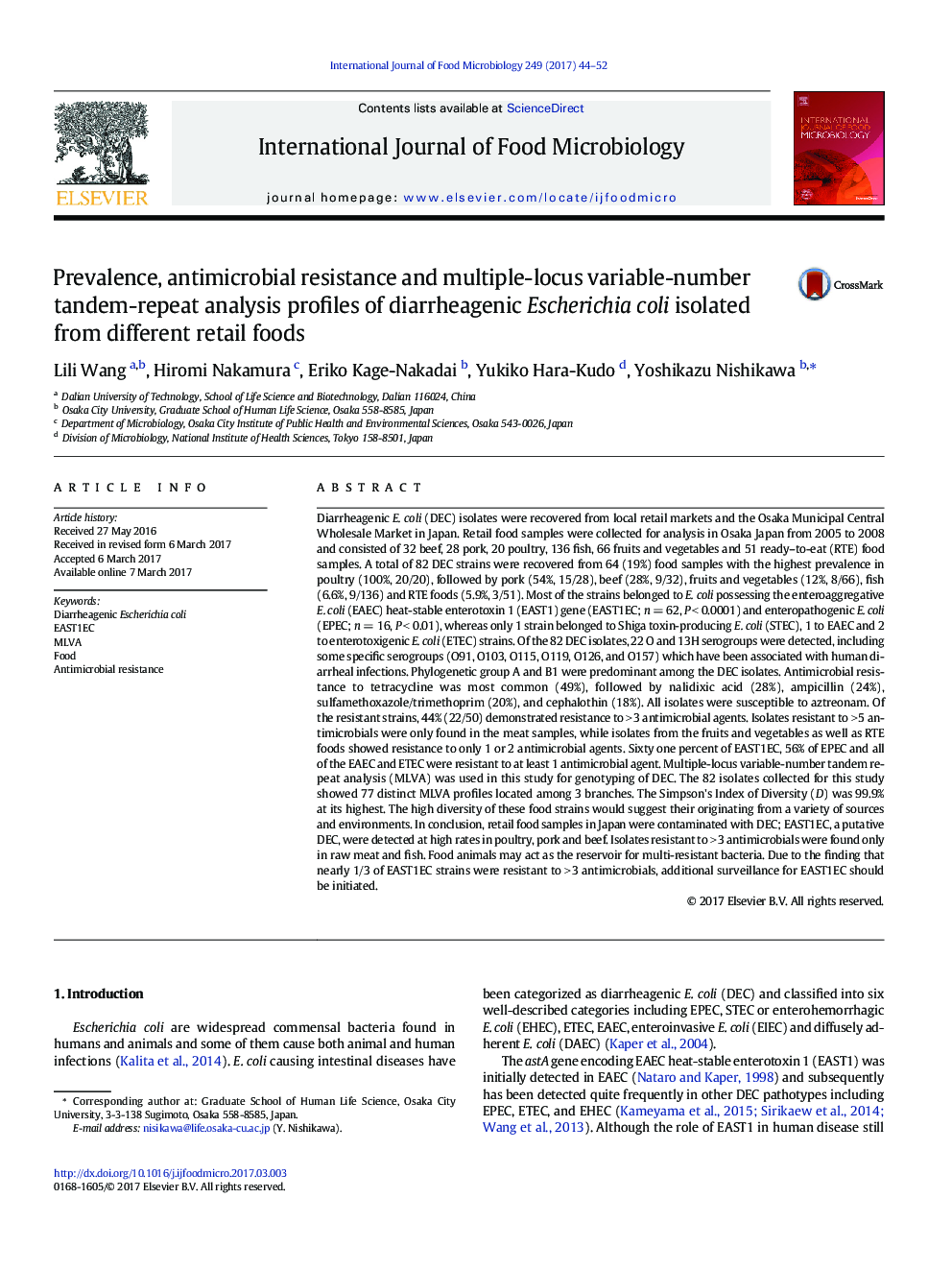| کد مقاله | کد نشریه | سال انتشار | مقاله انگلیسی | نسخه تمام متن |
|---|---|---|---|---|
| 5740840 | 1616534 | 2017 | 9 صفحه PDF | دانلود رایگان |

- EAST1EC (19%) was the most prevalent DEC in food samples.
- Nearly 1/3 of EAST1EC samples were resistant to > 3 antimicrobials.
- The phylogenetic group D strains showed the highest antimicrobial resistant property.
- The MLVA classification could be considered as a great screening method to discriminate DEC isolates.
Diarrheagenic E. coli (DEC) isolates were recovered from local retail markets and the Osaka Municipal Central Wholesale Market in Japan. Retail food samples were collected for analysis in Osaka Japan from 2005 to 2008 and consisted of 32 beef, 28 pork, 20 poultry, 136 fish, 66 fruits and vegetables and 51 ready-to-eat (RTE) food samples. A total of 82 DEC strains were recovered from 64 (19%) food samples with the highest prevalence in poultry (100%, 20/20), followed by pork (54%, 15/28), beef (28%, 9/32), fruits and vegetables (12%, 8/66), fish (6.6%, 9/136) and RTE foods (5.9%, 3/51). Most of the strains belonged to E. coli possessing the enteroaggregative E. coli (EAEC) heat-stable enterotoxin 1 (EAST1) gene (EAST1EC; n = 62, P < 0.0001) and enteropathogenic E. coli (EPEC; n = 16, P < 0.01), whereas only 1 strain belonged to Shiga toxin-producing E. coli (STEC), 1 to EAEC and 2 to enterotoxigenic E. coli (ETEC) strains. Of the 82 DEC isolates, 22 O and 13H serogroups were detected, including some specific serogroups (O91, O103, O115, O119, O126, and O157) which have been associated with human diarrheal infections. Phylogenetic group A and B1 were predominant among the DEC isolates. Antimicrobial resistance to tetracycline was most common (49%), followed by nalidixic acid (28%), ampicillin (24%), sulfamethoxazole/trimethoprim (20%), and cephalothin (18%). All isolates were susceptible to aztreonam. Of the resistant strains, 44% (22/50) demonstrated resistance to > 3 antimicrobial agents. Isolates resistant to > 5 antimicrobials were only found in the meat samples, while isolates from the fruits and vegetables as well as RTE foods showed resistance to only 1 or 2 antimicrobial agents. Sixty one percent of EAST1EC, 56% of EPEC and all of the EAEC and ETEC were resistant to at least 1 antimicrobial agent. Multiple-locus variable-number tandem repeat analysis (MLVA) was used in this study for genotyping of DEC. The 82 isolates collected for this study showed 77 distinct MLVA profiles located among 3 branches. The Simpson's Index of Diversity (D) was 99.9% at its highest. The high diversity of these food strains would suggest their originating from a variety of sources and environments. In conclusion, retail food samples in Japan were contaminated with DEC; EAST1EC, a putative DEC, were detected at high rates in poultry, pork and beef. Isolates resistant to > 3 antimicrobials were found only in raw meat and fish. Food animals may act as the reservoir for multi-resistant bacteria. Due to the finding that nearly 1/3 of EAST1EC strains were resistant to > 3 antimicrobials, additional surveillance for EAST1EC should be initiated.
Journal: International Journal of Food Microbiology - Volume 249, 16 May 2017, Pages 44-52